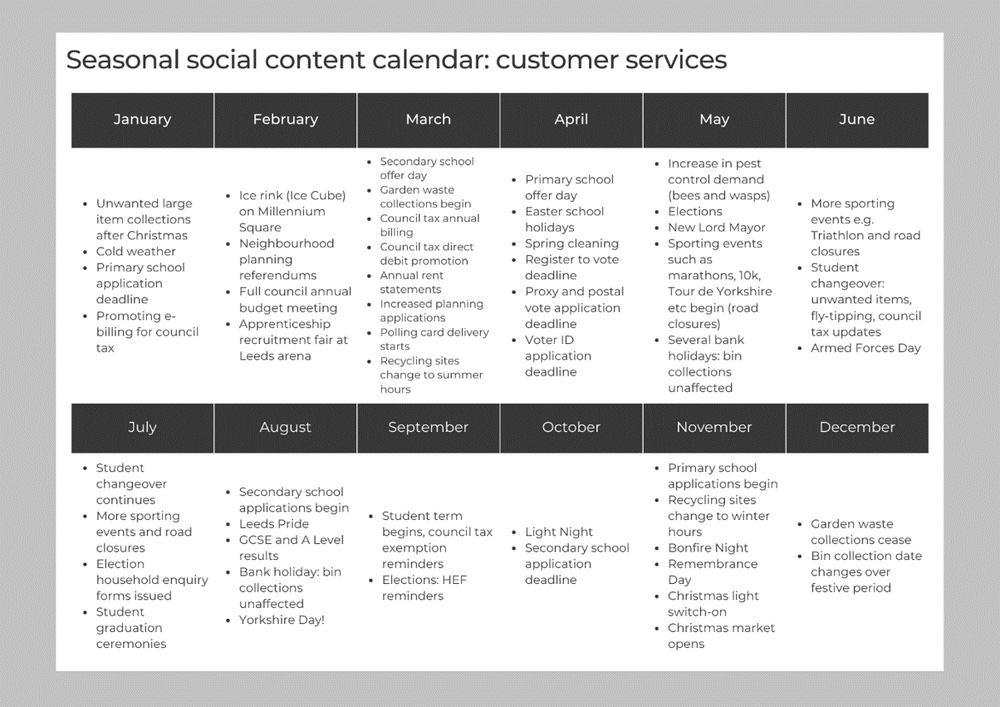Social media observations from a council front line
Local authorities’ social media channels offer a fascinating insight into trends within the communications industry…
I’m a digital development officer for Leeds City Council, who for the last eight years has managed the team within our contact centre that handles social media contact coming into our main corporate accounts. While supporting responses to thousands of incoming enquiries, I work hand in hand with our comms team on a daily basis, giving and receiving advice about all things social media, scheduling, analytics, and anything else we can dream of.
Trends I’m noticing on social
- Facebook remains to be our biggest customer platform.
- Reels, stories, and video content continues to grow on feeds, with more suggested content based on algorithms of what’s been watched before.
- Text and image based posts still perform well if they’re interesting enough, but they perform significantly better if they’ve been shared into groups. Group posts are more likely to show in feeds (especially to active members) than page posts.
- Groups still dominate feeds. Our staff-only Facebook group (around 6,000 members now) is an incredible success.
Inbound vs outbound: what’s the landscape? Top enquiry types and how they change
Seasonal enquiry types do tend to repeat year on year. The volumes slightly increase each year, unless something dramatic happens, when they can significantly increase. During the council tax rebate scheme that local government was told to administer, our council tax enquiries shot up to 4,000 in one month alone – four years ago that was the annual council tax enquiry figure.
These increases in response to dramatic events are echoed across all contact centre mediums. With demand being so unbelievably high, people struggle to get through, so will often try every outlet they possibly can. When they get a near-instant response (that actually answers their question, rather than telling them to ring up or email) word spreads. Satisfaction is clear – we’re often showered with compliments! More on that later.
Generally speaking, we know when people are likely to ask us about things, and we plan our content around that as well – which helps mitigate enquiries. This calendar pretty much sums up a generic year for us:

What it’s like to receive thousands of direct messages
- Our first point of call when receiving a DM is to encourage online self-serve, but as we all know, that’s not always possible, so we try and help wherever we can. Eight-eight per cent of our contact is either signposted online or dealt with directly by the social media team. The rest could necessitate a phone call/email or could be a completely different organisation that deals with it.
- Over the years we’ve encouraged this medium. The way people can have a passive conversation with us – send a message, put the kettle on, get a reply, say our thank yous and goodbyes – it’s a quality of life enhancement that allows people to go about their usual business without the cumbersome demands of navigating through IVR [interactive voice response] systems or waiting with blind anticipation in a queue for an officer to be connected.
- Our extensive list of internal contacts puts us in a brilliant position to be able to deal with whatever enquiry gets thrown at us. We can chase things up, escalate up the channels, and working as a team to find a resolution. It’s more difficult in a one-on-one customer service interaction to know everything about over 300 services, so with a mix of experience on the team, we can all help each other, help the customer, and learn something new every day in the process.
- We have also encouraged the use of this medium by making our social contact details to the footer on every page on our website. It’s hard to tell the exact impact of that as it happened at the same time as Covid, but anecdotally we do get plenty of people saying ‘I’ve heard I can chat with you using this.’
- I also see a noticeable increase in people who don’t have English as their first language getting in touch via social, especially when our student population is growing rapidly in Leeds (over 100k now). We often get people uncomfortable with phone systems who prefer to contact us, even if it does mean using Google Translate and taking a bit more time to explain things.
Posts that generate the most comments and engagement
- Across the wider social landscape with outbound, local news are considerably more reliant on clickbait, as well as comment bait. Almost all of the local news outlets I follow on Leeds start fierce debates with dramatic topics like ‘what goes first in a cup of tea, the milk or the teabag?’ or Heinz UK asking whether ketchup goes in the fridge or not. I’ve since seen local news ask the same question. Some of these things are more decisive than Brexit!
- Some brands still get away with text-based posts – you don’t need fancy graphics or videos if your content is great. Aldi are a classic example of this, and they are so quick to jump onto current trends and events. If one of their posts starts going viral, they’ll then put a paid boost on it to give it that extra amplification.
- For us, anything potentially controversial is guaranteed to spark debate, to the point where we have to be very careful when we schedule any potentially sensitive content to go out at a time where we can keep an eye on things, remove hateful comments, and so on. Most people on social media follow pages and are friends with people who are very much in their own political/social bubble, so when we have such a broad audience as a local council, fierce debates are inevitable, as people mix with those who they wouldn’t usually tend to. This broad demographic applies to us even more than local/national news; everyone knows to expect a different flavour of conversation on Daily Mail or GB News than the BBC or Guardian – instead, we get the lot!
- This can upset people. We’re quite thick skinned on our team, there’s probably not much in terms of hatred that we haven’t experienced, but that’s not an environment we want to foster. We’re putting a lot of work into guidance and support for staff around dealing with such incidents – so watch this space.
Compliments!
- People love a quick response. Our average first response time this year has been just under seven minutes on average, and people haven’t had to sit waiting during that time, they send the message, turn the phone off, then wait for a reply. It’s rapid, it’s chatty, sometimes there’s a bit of to-and-fro but we can quickly use a friendly tone of voice to build a rapport with people.
- One nasty comment can ruin your day, but in reality, those are few and far between. Sometimes it’s nice to take a step back and think about all the nice things people say to us – we should all be proud of that. Over the last year we’ve sent 43,000 replies, it’s a huge number, but there’s always one or two that stick in our mind!
Follower increases: do they matter as much now?
- Despite natural increases in followers, it doesn’t really change any level of volume or even organic reach that we get. People will often see many of our posts without needing to follow us – all they have to do is interact with them. Even if you stop scrolling when you see our posts, it still counts towards the algorithm of another similar post showing up in your feed. I feel like follower counts are a bit of a vanity metric, may as well report on the substance of your content and how people react to it instead.
- Your biggest audience is in the groups your content gets shared into, not your direct followers. You can try it out for yourself and see the results straight away when comparing analytics. Always compare analytics! Sometimes it can be easy to see why something’s gone down so well just from seeing how many places it’s been shared to.
Nick Moore is digital development officer at Leeds City Council. This blog was originally published on Comms2Point0 which is owned and created by Darren Caveney. Read the original post.

